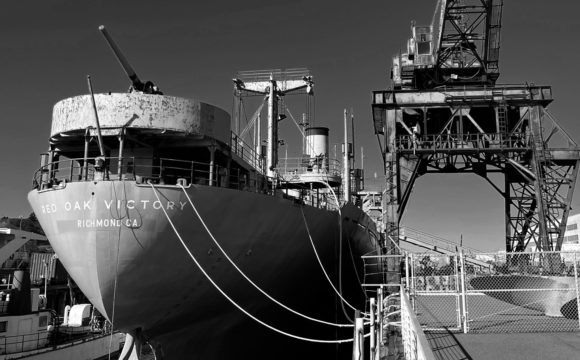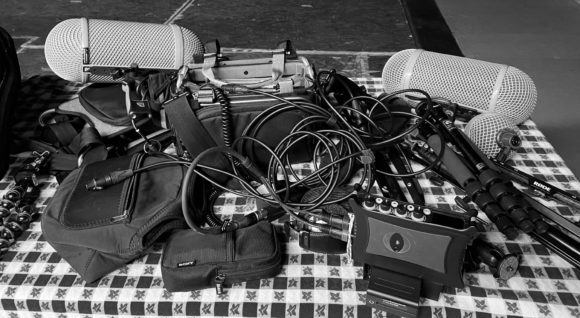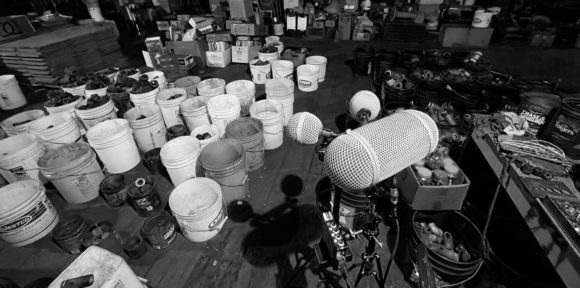Negotiating Location Access
Posted: June 20th, 2023 | Author: Nathan | Filed under: field recordingDespite my years of field recording and sound design, it wasn’t until recently that I negotiated my first location access for a personal recording project. It was easier than I’d had expected, but I also got lucky and had lots of factors in my favor. I thought I’d summarize my experiences for anyone who might want or need to negotiate access to a private or controlled location for field recording.
This article is intended for those who have never done this before; the process for much more involved locations for larger commercial projects is beyond the scope of this post.
A sound example of this outing is at the end of this article.
Lesson One: Passionate People Want to Share
My sea kayaking club had a meeting aboard the SS Red Oak Victory, a World War II ammunition freighter that’s now a floating museum and event space. The vessel is operated as a nonprofit and has a cadre of volunteers keeping her (ahem) ship-shape. That meant I could reach out to the Red Oak Victory’s crew and staff, and relay that I was already familiar with the vessel, but that I also had a genuine interest in her story.

What I didn’t expect, but is painfully obvious in retrospect, is that the ship’s staff are all volunteers. You don’t volunteer aboard a vessel like that if you don’t have a passion for it. And they want to show off the object of their passion! I couldn’t possibly ask enough questions of the crew and staff, and they were all incredibly supportive…and excited that anyone would “bless” their vessel with as peculiar an interest as audio recording!
Find a location with people who dearly love it, and find an authentic way to be interested not just in the location, but to understand their passion and share it.
Lesson Two: Educate Stakeholders about Audio Recording
As a nonprofit organization, I was happy to throw some money at the Red Oak Victory in exchange for my time aboard. But how much? In my favor, the ship also acts as a performance venue and has a rate card for rentals, including for photography clubs and video production/filming.

But their director of marketing had said no one had ever just wanted to record audio there, and had no idea what was involved, so how would we price it? Rather than make a rate suggestion, I outlined how my footprint on the vessel would differ from that of a film or video crew. One person just moving multiple recording rigs around. They offered a rate that was a small percentage of the full video-crew rate, which that seemed fair to all parties.
We also discussed noise levels; I wanted a mix of quiet and ambient activity. Learning that the crew is tools-down from noon until 1pm for lunch, we picked a time that bridged both activity levels, and the results were great.
As a recordist, it’s your job to both respect the location as well as educate its gatekeepers as to what your impact will be on the location.
Lesson Three: Start Small
Recording an entire vessel is a daunting task, and being unsure how my presence would be received, I wanted to use that first visit to show that I could be trusted and would be respectful.
So I started small. Ambiences, small hard effects (hatches, doors, etc.), and things that would keep me out of peoples’ way. At the end of the session, it was the Red Oak Victory’s staff that asked if I wanted to come back some time; “Maybe the cargo hoist could be fired up for you, it makes cool noises.” Hey, maybe that ship’s alarm I wasn’t prepared for could be tested on cue? “Yeah, we can definitely do that.”
Another sub-lesson here was that I had not yet learned Lesson One, so I could have pushed harder than I did for more access and more involved requests, because they wanted to share their passion for the ship!
So, use your instincts and balance what you think the location’s gatekeepers will allow with what you hope to accomplish. And as I learned, sometimes there’s such a thing as starting too small.

Lesson Four: It’s All About Relationships
Like everything else in life (and certainly in professional audio), it’s all about building relationships. I had a great time, and so did the crew and the staff. We joked about how I botched a recording of the coolest sound on the ship, and they laughed knowingly when I said it was the refrigerator compressor in the officers’ mess. Everyone felt respected and heard. And all parties are already talking about future visits. Heck, it turned out that they belong to an organization of other historic vessels, and maybe they could place a few calls on my behalf…
Even if you’ll only use a location once, build that relationship. Even if all you might need in the future is using that location’s gatekeepers as character references for others, you never know what connections might happen, even years down the road.
Yeah, yeah, yeah…but what did it sound like?
Here’s a sample of some of the recordings I made: This was recorded with a mid-side rig in the ship’s shaft alley, a 10-foot-wide by 170-foot-long corridor that houses the shaft that runs from the ship’s engine to its single rear propellor. I loved the ambient sounds of movement and work, which almost had an organized, musique concréte rhythm and dynamism to it.
noisejockey · SS Red Oak Victory: Distant Clangs
| No Comments »
Leave a Reply